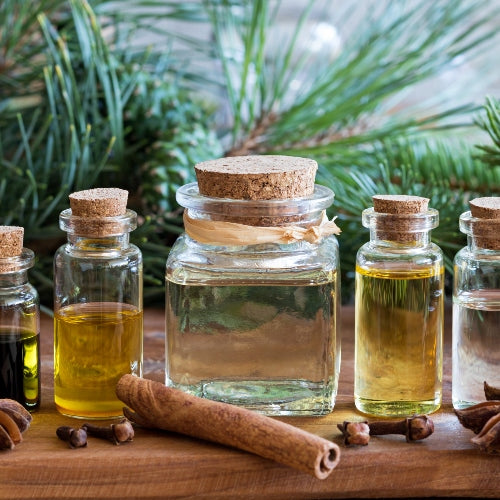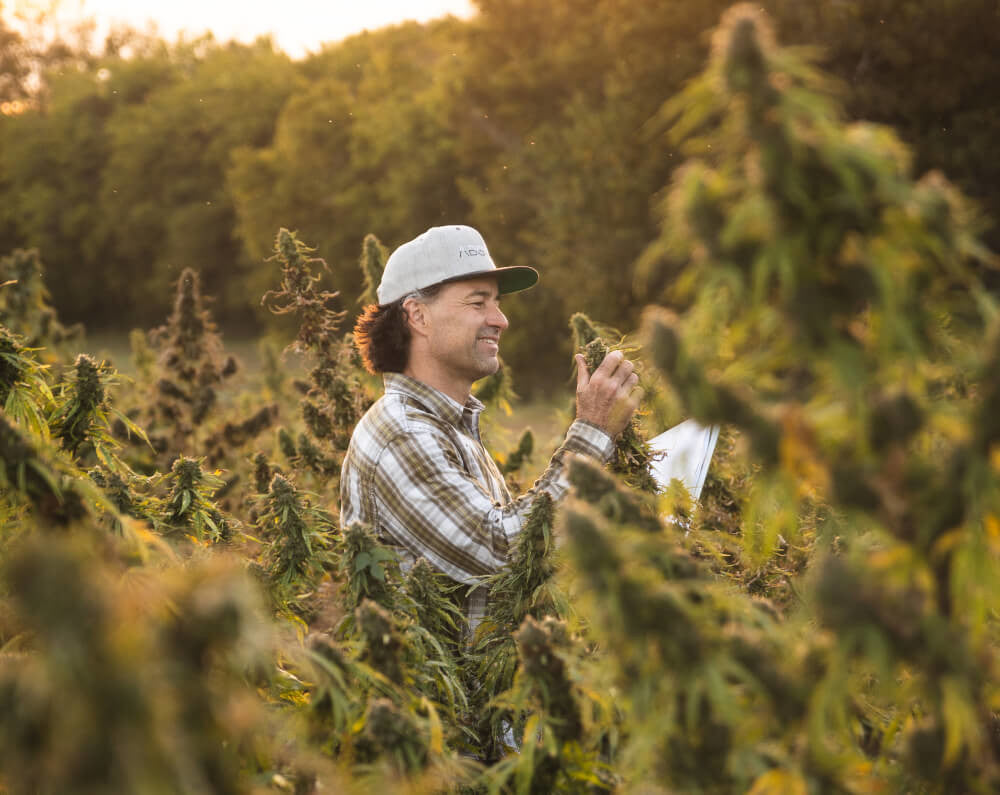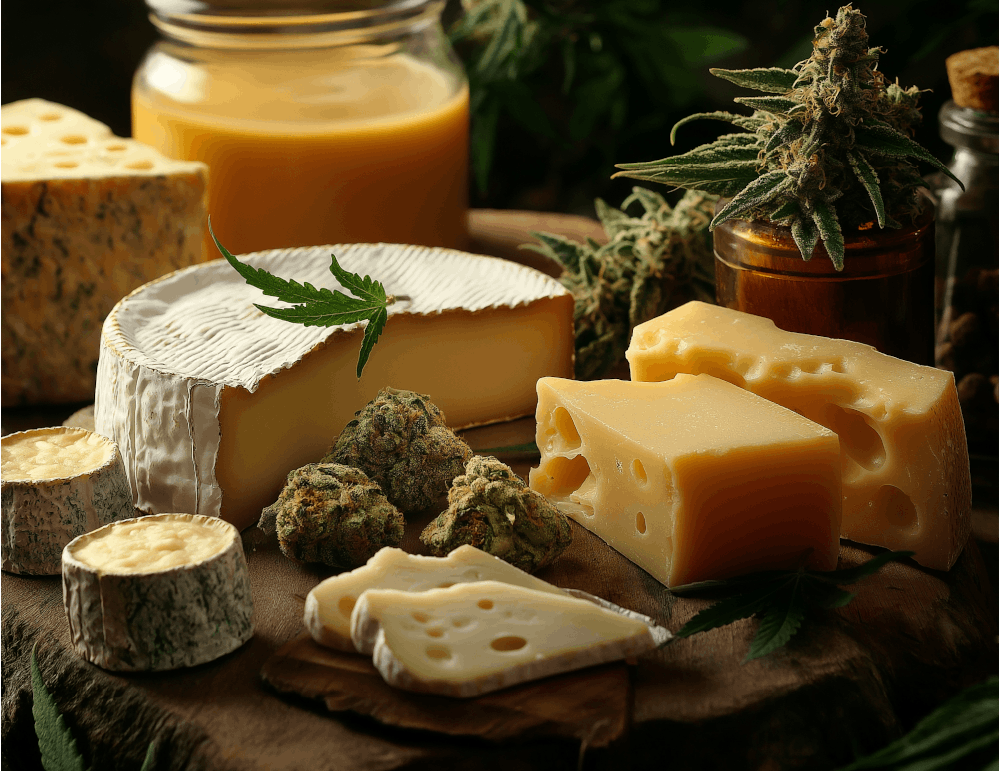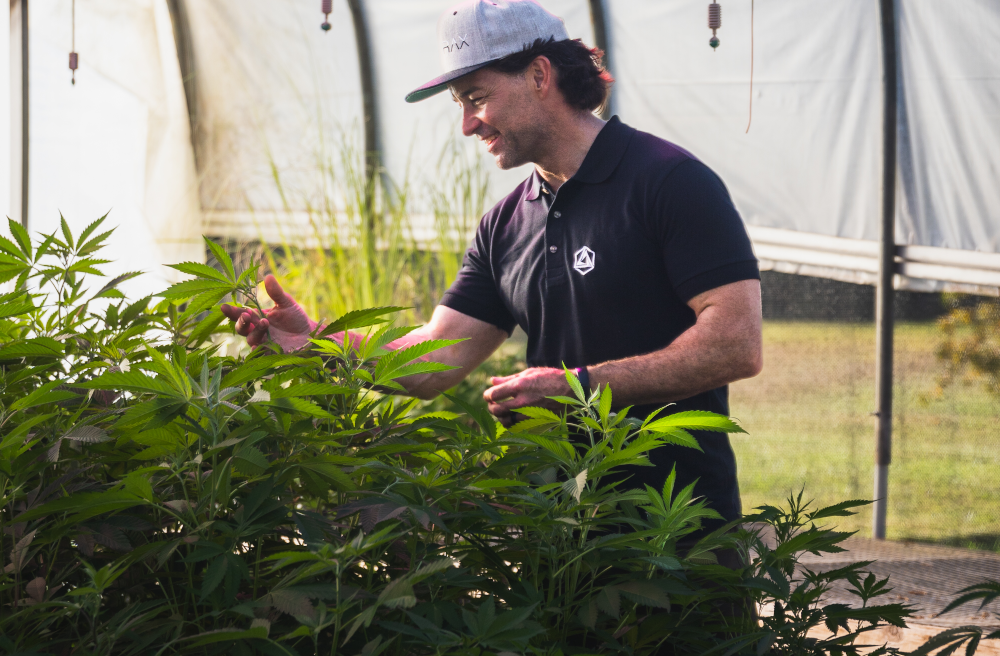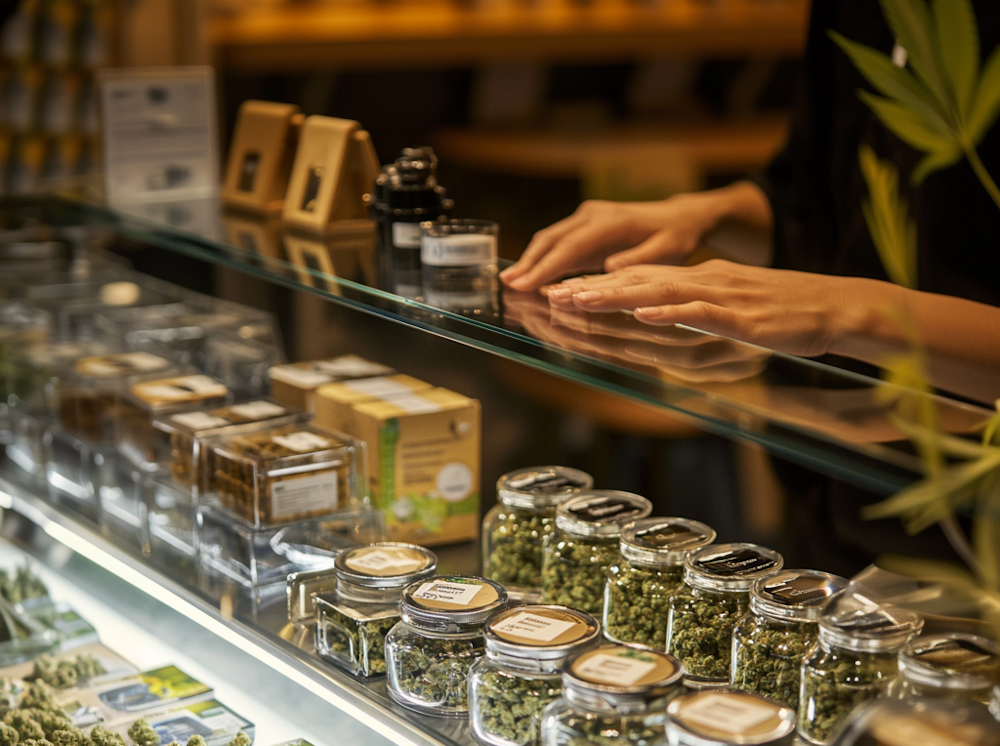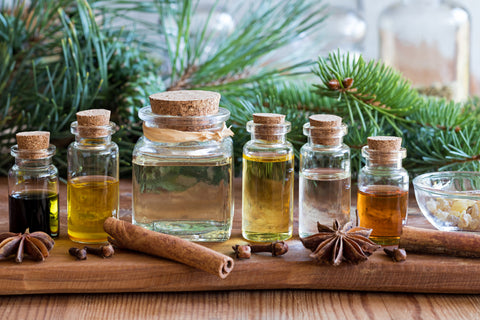
Think you have a solid handle on the entourage effect?
Think again.
Picture each strain as a locked treasure chest. Each treasure chest contains within it varying, unknown amounts of gold, gems, and plain old rocks. These are the organic compounds, like terpenes, inside your bud.
Now, if I ask you to pick a chest without knowing what’s inside, what would you do? Would you be happy if you picked one, only to open it up and see it filled mostly with useless gravel?
Doubt it.
Grab yo’ terp, call yo’ click. We’re talking all about the entourage effect in this post, including why non derived terpenes may have the edge when it comes to scaling your brand.
Check it out.
What is the entourage effect?
The entourage effect describes a phenomenon where the most well-known "c-compounds" present in strains and extracts act in a synergistic relationship with other chemicals present in the plant called terpenes or terpenoids, to produce different and/or stronger effects than the individual compounds do alone (1).
It’s well-established that c-compounds, have different effects on the human body through their biochemical interactions with the human body's EC System system. (2)
“But wait,” you say. “You sell terpene isolates and not whole plants of any kind. What gives?”
Allow us to explain.
How Your Brand Can Use Terpene Isolates to Harness the Entourage Effect

If you’ve read this far, you understand that different combinations of organic compounds like terpenes and others result in different medicinal benefits of varying strengths.
But when you use the whole plant (or even the essential oil derived from that plant), it’s like reaching into a grab-bag at your kindergartener’s birthday party:
You have no idea how much of each compound you’re getting.
What if you could look up the therapeutic benefits of individual terpenes and optimize your cream or other product for those benefits by controlling the terpene levels?
Oh, wait. That’s exactly what Abstrax helps you do.
See, companies already use terpenes as commercial fragrance and flavoring agents, as the US Food and Drug Administration (FDA) has approved most of them for human use and consumption (3). This means adjusting the terpene levels will adjust the flavor and aroma of your products and foods.
But researchers have also studied the therapeutic potential of terpenes alone, and their results suggest different terpenes have anti-inflammatory, pain-management, antifungal, and antibacterial properties, among others (4). Plus, different terpene profiles may counteract some of the more undesirable, intoxicating side effects of medical through the entourage effect by acting on c-receptors (1) (5).
Derived Terpenes vs Non Derived Terpenes: It Matters.
Word on the street is derived terpenes are always superior to those derived from other plants.
When talking about terpene isolates, we rate this urban legend as FALSE.
Sure, you can think of derived blends (where manufacturers extract a full terpene mix then mix with distillate) as better or worse than blends extracted from other botanical sources depending on your preferences. Just think of the treasure chest analogy and ask yourself, “Am I comfortable with potentially disappointing surprises and uncertainty when purchasing a product?” to figure out where you stand.
But there is a clear difference in what you’re spending your hard-earned capital on if you’re buying blends from untrustworthy sources who fail to remove solvents properly for ultimate purity.
While there is a difference between botanically derived terpene and derived terpene blends due to these unknowns, the isolates are the same. Limonene isolates, for example, will produce the same tastes and effects for your product whether it’s extracted from an orange or OG Kush itself…
That is, provided it’s purified using the molecular distillation process that helped put Abstrax at the top of its class and win multiple awards for our terpenes.
This process allows you to capitalize on two significant benefits of our botanically derived terpene blends:
- They give your products a level of consistency nature cannot match. This is because plant metabolites (terps included) can change with a variety of factors if not controlled for as we do, like
- Temperature
- Lighting
- Length of grow-time
- Nutrition schedule
- Humidity
- Stressors such as pests or mold (gross)
- Time of harvest
- Curing process
- and more.
Here are some of our fans’ favorite terpene isolates.
Popular Terpenes Involved in the Entourage Effect
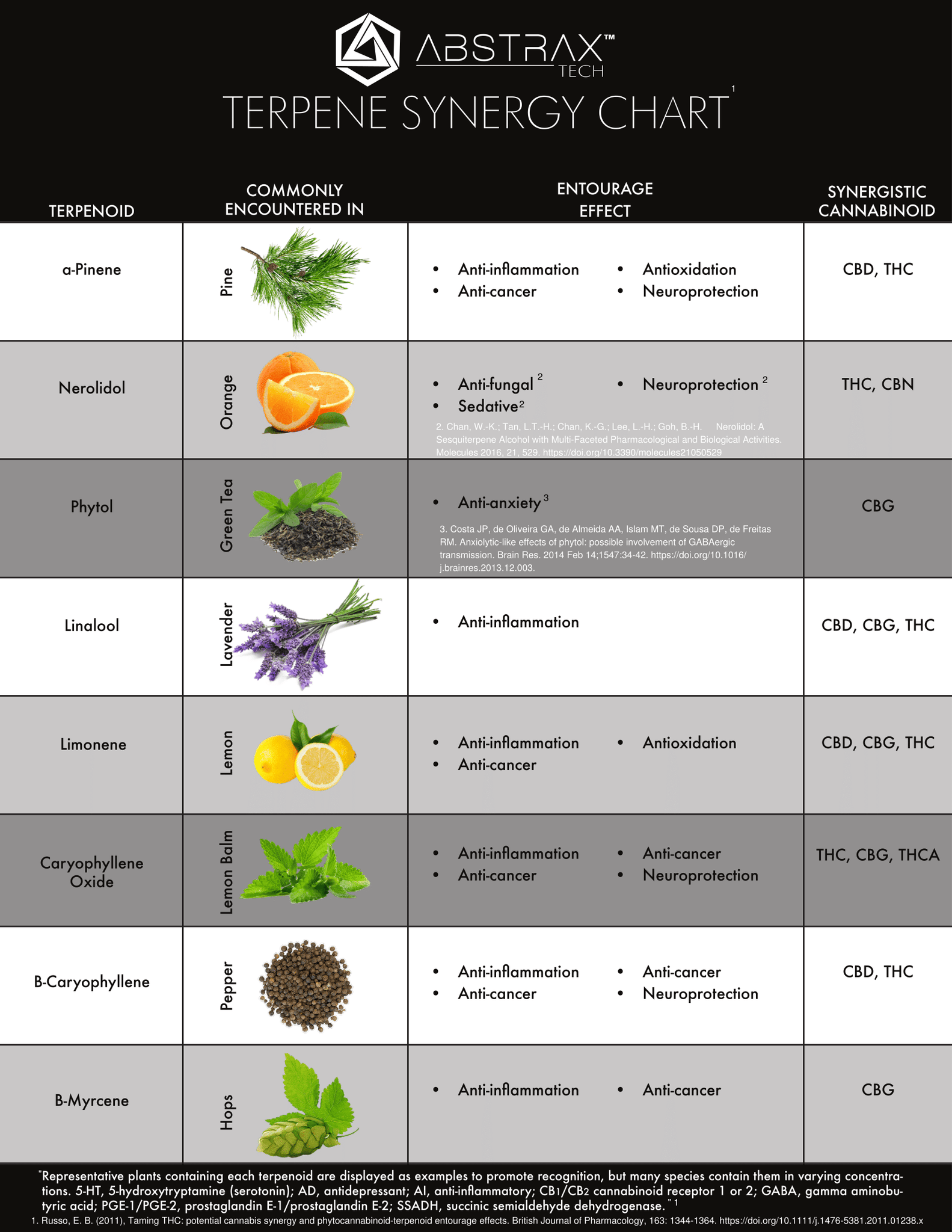
Some terpenes are of particular interest to researchers in the industry trying to make more potent, specially purposed strains and oils using the entourage effect. When studied by themselves, the findings suggested many of these terpenes boast multiple health benefits (4).
Here’s a list of some of the most common health benefits and interactions:
- Alpha-pinene gives Sativa strains the faint aroma of a pine forest. Studies suggest low-exposure levels of alpha-pinene possess anti-inflammatory properties, antimicrobial properties, antiulcerogenic and gastroprotective properties, and may counteract short-term memory deficits induced by the consumption of certain compounds (1) (5). Alpha-pinene may have anti-inflammatory effects when acting synergistically with certain compounds (6) and act as a bronchodilator synergistically with other compounds(7).
- D-Limonene, a terp commonly found in lemons and oranges, has shown promise as a potential immunostimulant (8) in synergy with certain compounds.
- Beta-myrcene, a terpene commonly found in hops, acts as an anti-inflammatory (10) in addition to showing analgesic effects (11) in synergy with specific compounds.
- Linalool, a terpene found in lavender, may have potential anesthetic properties (12) and inhaled sedative properties (13) in synergy with other compounds. Plus, it synergistically enhanced the antimicrobial activity of specific essential oils when added to them (14).
- Beta-Caryophyllene, a terpene responsible for the distinctive taste of black pepper, is another interesting terpene that may improve through the entourage effect. Beta-caryophyllene may be useful for its gastroprotective effects (15) in synergy with certain compounds, in addition to its general anti-inflammatory effects (16).
- Caryophyllene-Oxide, a terpene found in lemon balm plants, shows promise as an anticoagulant (17) in concert with other compounds.
- Nerolidol, a terpene encountered in oranges, may have sedative properties when working in tandem with certain compounds (18).
- Camphor, found in lavender and rosemary oil, has antibacterial, antifungal, insecticidal, anti-neuralgic, cardiac stimulatory, immune stimulatory, antitussive, anti-inflammatory, anti-senescent skin rejuvenating. It may aid in the industry development of healing based balms and salves, as well as help relieve pain and inflammation from muscle aches or the common cold (19).
-
Geraniol, a terpene found in geranium and rose oil, is another terpene that has shown promising anti-inflammatory (20) and antioxidant (21)
Preliminary research on these terpenes and more shows there is great therapeutic potential within these compounds (4). As research evolves, researchers will continue to unlock new ways in which we can use the entourage effect to produce new products tailored to individuals with specific therapeutic needs.
Conclusion: Start Experimenting with the Entourage Effect

Achieving a better understanding of the entourage effect may lead the industry to develop new strains with specific terpene profiles, and may result in strains and products designed to treat “pain, inflammation, depression, anxiety, addiction, fungal and bacterial infections” (1).
The discoverer of our favorite compound, Raphael Mechoulam, said that the therapeutic potential of the different compounds contained inside various plants is a “neglected pharmacological treasure trove (2).”
While this is true, Dr. Ethan Russo acknowledges the recently discovered importance of terpenes in his comprehensive review in the British Journal of Pharmacology (1). In the review, Russo states, “... [terpenes] display unique therapeutic effects that may contribute meaningfully to the entourage effects of based medicinal extracts” (1), pointing at terps’ role in influencing the entourage effect.
Terpenes are clearly the next untapped treasure trove inside a range of already-familiar plants. Luckily, Abstrax is here to help you crack the code and crush the competition by experimenting and formulating your own entourage effects.
